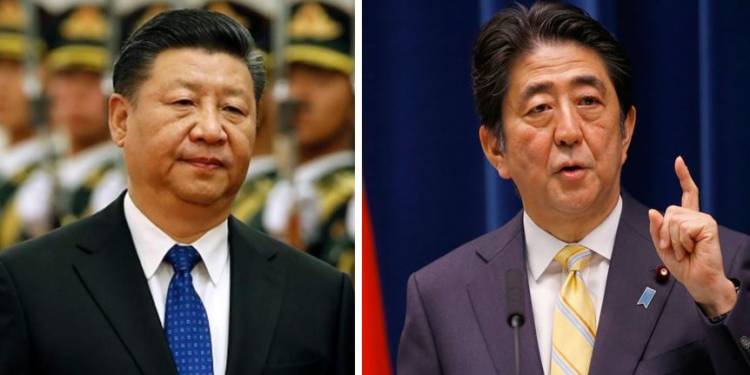Relations between arch-nemesis China and Japan are deteriorating and the latter is not taking any chances and is rapidly building its defence to be ready for any eventuality against the vile Chinese—with the worst-case scenario being a war.
Japan has built an anti-ship supersonic stealth missile – ASM-3, that can overwhelm Chinese targets. Chinese belligerence in the East and South China Seas has grown unprecedently and Japan has sent out a timely message to the PLA Navy with the entry of the deadly stealth missile.
Developed by Mitshubishi Heavy Industry, the ASM-3 is a supersonic missile that could prove to be a game-changer for Japan to counter the Chinese (PLAAF) warships. According to Eurasian times, the missile hits its target five times faster than the speed of sound, making directional enhancements by itself, almost impossible to detect like a stealth fighter jet and carries a “Sea Buster” tandem charge warhead designed to annihilate surface warships and aircraft carriers.
A possible war against China will involve the Japanese Navy preventing Chinese battleships from reaching the open Pacific and the ASM-3 will assist help them achieve this goal.
The ASM-3 boasts a 200-mile range—twice its original specification after the previous version was deemed unsatisfactory by the Japanese Defence Ministry.
Ever since Japan-China tensions escalated, Tokyo has bolstered its military strategy. In March, Japan’s bicameral legislature, the National Diet, approved a whopping $46.3 billion defence budget to majorly counter the increasingly hostile dragon.
The confrontation over the Senkaku Islands
Historically, Japan does not share a pleasant relationship with Beijing. The territorial disputes and World War II embittered grievances have marred the Japan-China relationship for decades. Recently, China violated Japanese waters for a record time of 40 hours.
Most recently, The Japan Times quoted government sources as saying that Japan is now immediately scrambling its fighter jets in response to every Chinese military aircraft taking off from a Chinese airbase in the Fujian Province. The report comes amidst rising tensions over the Senkaku Islands which are called Diaoyu Islands by China.
China unceremoniously claims rights over Senkaku Islands which Japan has been administering since 1972. The Island group is situated 1,931 km Southwest of Tokyo. Ever since the Coronavirus Pandemic gripped the world in April, Chinese vessels have also been hovering around the disputed Senkaku Islands in the East China Sea.
This island chain is called Diaoyu Islands by Beijing and it is bullying Japan to give up the controls over it. However, Japan has tightened its grip on the disputed Islands by inserting the Japanese name “Senkaku” to counter the Chinese name Diaoyu.
The Japanese Assembly had changed the name of the administrative area containing the Senkaku Islands from “Tonoshiro” to “Tonoshiro Senkaku.”
A few months back, four Chinese Coastguard vessels had entered the Japanese waters near the uninhabited Senkaku Islands and started chasing a Japanese fishing boat. But Japan confronted the Chinese vessels and warded them off with a warning.
Beijing itself admits having intruded into the Japanese waters and the Chinese Coastguard had stated that its vessels had “patrolled the territorial waters around the Diaoyu Islands.”
Growing anti-China sentiment and Companies leaving China
There is a growing anti-China sentiment in Japan for several reasons. Tokyo had invested heavily in the Olympic Games, a whopping $12.35 billion US dollars to be precise, but the Wuhan virus crushed Japan’s Olympic dream. Miffed by the role of the WHO under Dr Tedros, the Japanese Deputy Prime Minister went on to say that the World Health Organisation might have to change its name to “Chinese Health Organisation.”
Recently, a total of 87 companies signed up with the Japanese Ministry to move manufacturing units out of China, with 57 moving back to Japan and 30 to different Southeast Asian nations like Vietnam, Thailand, and Laos.
Japan is already a part of the Quad with India, Australia and the USA and together these four countries had conducted a naval exercise in the Indo-pacific region to send a strong message to China.
If India includes Australia in this year’s Malabar exercise then China’s worst dream might come true as the Quad will be potentially called Asian-NATO by then. Till now the Quad has proclaimed itself a military group but the changing dynamics of the region due to China’s misadventure has given indications that this group can certainly head down the path, in the future, if necessary.
With such developments taking place in its vicinity and Japan being on a continuous offence, the fluttering Dragon has been pushed to the corner. The ASM-3 supersonic missile is going to further miff the Chinese but they will also be made to think twice before taking another vile manoeuvre against Japan.
